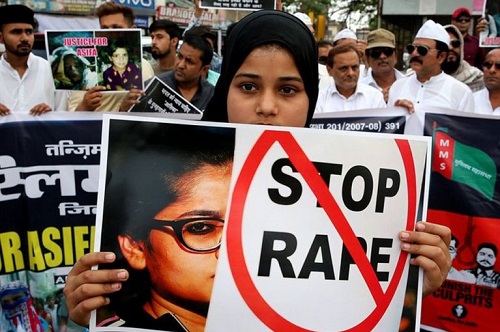EPA photo
By
Sarthak Goswami
December 16, 2012 marked the incident which would leave India berserk and outraged for years to come. An ordinary twenty-three year old physiotherapy student returning home on a December night was abducted, gang-raped, tortured and mutilated inside a moving bus on the bustling Delhi roads. The incident, exemplified by its brutality, sent shivers down the spine of billions. A revolutionary outrage followed, millions coming down the street, protesting and demanding justice for the victim. The entire nation stood integrated for the call for justice, backed outright by a robust media coverage. In fact, the magnanimity of the civil enrage forced the UPA government to amend stringent laws in the constitution to ensure severe punishment for the rape crimes. Six years forward, India sees itself standing in a similar unease, this time the elements more piercing. An eight-year old was abducted, gang-raped and eventually killed in Kathua, a small village in the troubled state of Jammu and Kashmir.
Many invariables distinguish the two cases. Nirbhaya (a fictional name given to the 2012 gang-rape case) was a young girl of a metro-city, a factor which drives more familiarity and empathy to the common Indian. The eight-year old victim of Kathua was a nomad village girl, a child not even mature enough to comprehend the very abhorrent crime she fell victim to. Nirbhaya was raped inside a moving bus for a few heinous hours while in Kathua, the crime went on for several days inside the dome of a holy temple. The brutality however is a tough subject to debate upon, foreign objects inserted inside the body in the former while the victim was drugged in the latter. The uterus was ruptured in both. But the noticeable difference which made the Kathua case stand out was that it had a political agenda.
The girl belonged to the Bakharwal tribe, a minority of Muslim nomads of the area. Some radicalized Hindus plotted the crime to scare off the Bakharwals from the town. They kidnapped her when she went out in the forest to bring back the horses. The poor girl was held captive inside the worship area of the temple. She was drugged, starved, beaten and gang-raped by several men including a police officer who was specially invited from Meerut to satisfy his monster on an eight-year old. When the girl died due to internal injuries, her head was stormed to death with a stone, finally ending her misery. All this done to oust a Muslim Bakharwal tribe from the town.
This is both difficult to read and to write.
‘Man is a monster’, the proverb no more sounds offensive, it is alive and screaming with a forwarded question- ‘How monstrous can the man monster become?’
After the heinous crime was reported and the police started the probe, that became the point from which the dirt got filthier. The accused, fearing arrest, tried to bribe the cops with 1.5 lakh rupees to settle an under the table deal. When the cops came in to arrest them, a team of lawyers set up a Hindu Ekta munch, joined by two MLAs from the incumbent BJP government with overt support to stop the arrest and quash the case. Furthermore, a rally was organized for the cause, the Indian tri-color was used to give the protest a nationalistic angle and slogans of ‘jai shree Ram’ were shouted.
No lines remained uncrossed. A brutal juvenile gang-rape case had been given a political and religious touchup, with the involvement of government officials. Initially, the mainstream media eluded reporting the case, but to the courtesy of social media and civil outrage, the incident did catch a blaze. The infuriating part of the whole incident was that neither the government nor the opposition seemed interested in Kathua’s call for justice. A few days later, Rahul Gandhi, the leader of the opposition party issued a statement condemning the incident, while the ministers of the ruling government, who became berserk in the Nirbhaya case, condemning the then incumbent congress government on its impotency for women safety, were shut silent and refrained from speaking on the issue. You don’t need to ask why, the answer is simple – the fear of losing a robust Hindu vote bank in the Jammu valley. However, after immense political pressure the two ministers who attended the rally submitted their resignation and Prime Minister Modi issued a statement guaranteeing punishment for the convicted, but those steps seemed rather forced and fearful, not out of heartfelt misogyny.
So the question dangles. Has politics in India stooped down to that level? An eight-year old’s misery and justice weighs lower than a certain vote-bank’s interest in the eyes of political parties?
Religion has started to hold stakes in justice, and this is a problem India has never faced.
Sarthak Goswami
My name is Sarthak Goswami. I am pursuing my graduation in Journalism and Mass Communication from Indraprastha University, Delhi. I worked as an editorial intern for the BusinessWorld magazine.



No Comments Yet!
You can be first to comment this post!